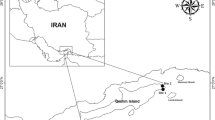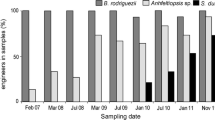Abstract
The kelp bed of Gouqi Island lies in the east of the East China Sea, in the Shengsi Archipelago. It is a key component of the island-reef ecosystem. This study evaluated kelp beds on intertidal and subtidal zones from 2004 to 2006. We evaluated seasonal variations in the community structure of macroalgae, and their relationship with water temperature, nitrogen and phytoplankton. The Gouqi Island kelp bed consists mainly of species of Sargassum. Sargassum horneri was the dominant species in subtidal zones, representing 90% of the total biomass. The dominant species in intertidal zones were S. fusiforme, S. horneri, S. thunbergii and Undaria pinnatifida. Fifty-four phytoplankton species were found in the Gouqi Island kelp bed, of which 51 species were found inside the kelp beds, 43 species outside the kelp beds, and 40 species were present both inside and outside the kelp beds. Diatoms were dominant both inside and outside the kelp beds. Except in winter, Skeletonema costatum was dominant, and its abundance in autumn was over 98% of the total abundance. Water temperature was found to be the primary factor influencing the growth of S. horneri in the Gouqi Island kelp bed. S. horneri grew slowly from November to March, and rapidly from March to June. The upper temperature limit for growth of S. horneri was about 18°C. Higher water temperatures can result in a decline in the kelp bed. Nitrogen seemed to be a limiting factor for macroalgal growth. This was particularly true for S. horneri and phytoplankton. Since nitrate is the primary nutrient for S. horneri, its absorption by S. horneri resulted in seasonal changes of nitrate in the ecosystem.
Access this chapter
Tax calculation will be finalised at checkout
Purchases are for personal use only
Preview
Unable to display preview. Download preview PDF.
Similar content being viewed by others
References
Calbet A, Landry MR (1999) Mesozooplankton influences on the microbial food web: direct and indirect trophic interactions in the oligotrophic open ocean. Limnol Oceanogr 44:1370–1380
Calbet A, Landry MR (2004) Phytoplankton growth, microzooplankton grazing, and carbon cycling in marine systems. Limnol Oceanogr 49:51–57
Chang KM, Wu JF (2007) Study on artificial propagation of mussel Mytilus coruscus. South China Fish Sci 3(3):26–30
Duggan RE, Miller RJ (2001) External and internal tags for the green sea urchin. J Exp Mar Biol Ecol 258:115–122
Justic D, Rabalais NN, Turner RE, Dortch Q (1995a) Changes in nutrient structure of river-dominated coastal waters: stoichiometric nutrient balance and its consequences. Limnol Oceanogr 40:339–356
Justic D, Rabalais NN, Turner RE (1995b) Stoichiometric nutrient balance and origin of coastal eutrophication. Mar Pollut Bull 30:41–46
Komatsu T, Tatsukawa K (1999) The kelp beds and aquatic product resource. Ocean, No.17, Japan
Konar B, Estes JA (2003) The stability of boundary regions between kelp beds and deforested areas. Ecology 84:174–185
Li H, He H, Jin QZ (1999) Trophic niches and potential yields of three economic bivalves in Daya Bay. Trop Oceanol 18(14):53–60
Liu JW, Dong SL (2001) Nutrient metabolism and the major nutrient uptake kinetics of seaweeds. Plant Physiol C 37:325–330
Liu JW, Dong SL, Ma S (2001) Effects of temperature and salinity on growth of G. tenuistipitata var 1iui, U. pertusa, G. filicina and NH4-N uptake of G. tenuistipitata var 1iui. Acta Oceanolo Sin 23(2):109–116
Lu DD, Zhang ZD (1996) Studies on phytoplankton and red tide causative species in the sea area near Ma’an Islands of Zhejiang. Donghai Mar Sci 14(1):44–51
Maci’a S, Lirman D (1999) Destruction of Florida Bay seagrasses by a grazing front of sea urchins. Bull Mar Sci 65:593–601
Ocean Reconnaissance and Design Academy in Zhoushan (2004) Aquiculture arrangement and layout in Shengsi, China. http://www.zj-ssyb.com.cn/news.asp?ID=8. Cited 20 Nov 2006
Pu XM, Wu YL (2000) Review of nutrient limitation of phytoplankton. Mar Sci 24(2):27–30
Redfield AC (1958) The biological control of chemical factors in the environment. Am Sci J 46:205–222
Shen GY, Shi BZ (2002) Marine ecology. Science Publishing, Beijing
CSBTS (State Bureau of Quality and Technical Supervision of China) (1998) Seawater analysis. In: The specification for marine monitoring part 4. CSBTS, Beijing, China
Statistic Bureau in Zhoushan City (2001) Zhoushan Statistical Almanac. Chinese Statistic, Beijing
Sun J, Song SQ, Wang D, Xu ZL (2007) Estimating Calanus sinicus grazing on phytoplankton and microzooplankton. Acta Ecol Sin 27(8):3302–3315
Watanuki A (2006) Restoring kelp beds to healthy and strong from the Isoyake. News Letter, No.151, Ocean Policy Research Foundation. http://www.sof.or.jp/ocean/newsletter/151/a01.php. Cited 2 Aug 2007
Wheeler K, Kokkinakis D (1990) Ammonium recycling limits nitrate use in the oceanic subarctic Pacific. Limnol Oceanogr 35:1267–1278
Zhang SY, Wang ZH, Lin J (2007) Variation of fisheries resources in summer and autumn in seaweed beds of Gouqi Island. Mar Fish Res 28(1):45–52
Author information
Authors and Affiliations
Corresponding author
Editor information
Editors and Affiliations
Rights and permissions
Copyright information
© 2008 Springer Science + Business Media B.V.
About this chapter
Cite this chapter
Zhang, S.Y., Wang, L., Wang, W.D. (2008). Algal communities at Gouqi Island in the Zhoushan archipelago, China. In: Borowitzka, M.A., Critchley, A.T., Kraan, S., Peters, A., Sjøtun, K., Notoya, M. (eds) Nineteenth International Seaweed Symposium. Developments in Applied Phycology, vol 2. Springer, Dordrecht. https://doi.org/10.1007/978-1-4020-9619-8_49
Download citation
DOI: https://doi.org/10.1007/978-1-4020-9619-8_49
Received:
Revised:
Accepted:
Publisher Name: Springer, Dordrecht
Print ISBN: 978-1-4020-9618-1
Online ISBN: 978-1-4020-9619-8
eBook Packages: Biomedical and Life SciencesBiomedical and Life Sciences (R0)




